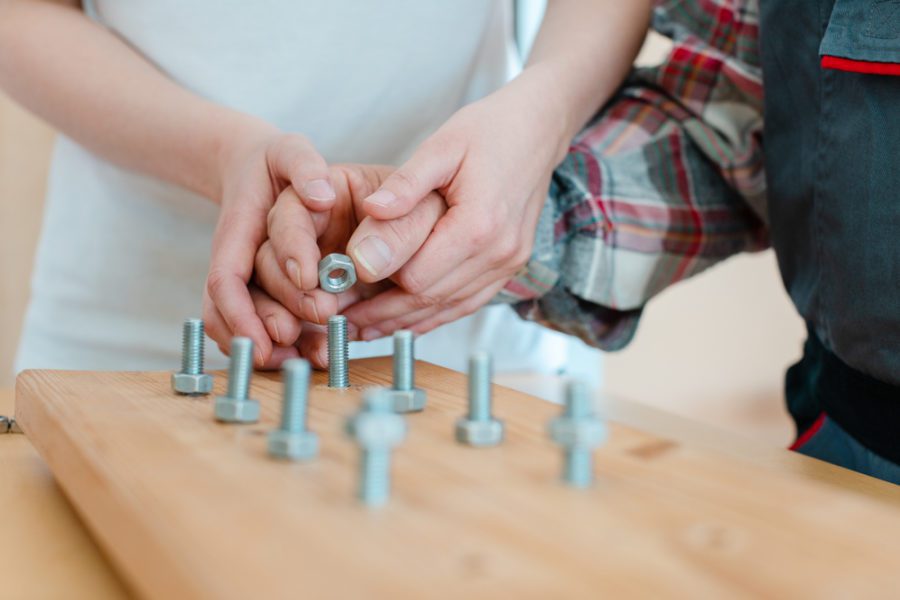As an occupational therapist, your singular focus is to help your patients maintain or return to a fulfilling life. But the way to do that looks very different across each person you work with.
Your approach has to be catered to the individual—so do your tools.
With so many methods, resources, and equipment pieces out there, it takes time to identify the most important therapeutic tools that can address all of your patients’ different needs, whether that’s regaining fine motor control, re-learning how to walk, or eliminating discomfort and dysfunction in daily activities.
These 15 versatile supplies will prepare you with a handy toolkit that can continue to grow as your travel therapy practice does.
Assistive Walking, Standing, and Seating Devices for Functional Mobility
One major piece of the OT-puzzle is helping patients learn or re-learn basic movements like walking and standing. These patients often have severe physical limitations, such as paraplegia, quadriplegia, cerebral palsy, and other physical-developmental disabilities.
These assistive mobility devices are some of the largest pieces of equipment you’ll likely use and recommend in your line of work.
#1 Wheeled Walkers and Rollators
Commonly associated with the elderly, these wheeled walking devices work well for patients who aren’t quite stable enough to use more traditional walkers without wheels. For pediatric occupational therapy purposes, you can find dedicated children’s rollators in two configurations:
- Anterior support – Users will lean forward on the support bar in front of them and push the walker forward. This type of device is necessary for patients who have to rely on the walker to stay upright or for weight-bearing purposes.
- Posterior support – Alternatively, the patient presses down on the support bars on either side of them, pulling the walker forward as they walk. This physical shape allows for a healthier posture and a more stable walk and is better suited for patients who often lose their balance and fall backward.1
#2 Gait Trainers
These wheeled support devices also help with walking, specifically for patients relearning basic mobility after an accident or who have stability issues. By encouraging proper posture and increasing muscle strength, they ease the transition back into unassisted walking.
#3 Sit to Stand Frames
For wheelchair-confined patients, standing for even a small period of the day can have significant health benefits, including:2
- Improved circulation
- Respiratory ease
- Healthier digestion and bowel movements
- Increased bone density and strength
With an assisted standing device that supports the three most important points—a seat, knee pads, and a chest pad—your patient can vary their position throughout the day.
They also have handy features for self-users to easily switch between sitting and standing unassisted by an aide or doctor.
Sensory-Friendly Seating Options for Coordination and Focus
Anyone who struggles with focus and prolonged stillness can benefit from alternative seating arrangements that provide more sensation and stimulus than a hard plastic chair.
#4 Exercise Ball
This is one example of occupational therapy equipment making its way into the public sphere, as plenty of students and workers find benefit in sitting on an exercise ball. Because of the uneven surface, the user has to actively balance and shift to remain upright. This ongoing physical engagement can improve posture and balance, plus direct focus away from external stimuli and stressors, especially with a textured ball.3
But an exercise ball is for more than just sitting—it’s for exercise, too. This is an important, versatile tool because many physical therapy exercises and stretches require one.
#5 Wiggle Cushion
This portable, somewhat inconspicuous device provides similar benefits as an exercise ball but can be used in a variety of ways for greater accessibility and usefulness:
- Place the cushion atop an existing chair seat for increased sensory stimulation.
- Put the cushion on the ground and have your patient stand and balance on it during classroom activities, for example. This is perfect for movers and shakers who like to shift positions constantly.
#6 Rocker Chair
In a rocker chair, your patient can move back and forth in their seat, which can often help them self-regulate and keep calm through soothing kinetic sensation.
Accommodations for Honing Fine Motor Skills
Occupational therapy addresses mobility difficulties, both big and small. Simple hand movements, like writing, drawing, and hand-eye coordination tasks are a major focus for many OT specialists and require a whole workbox of supplies.
#7 Weighted Pencils
Many students with autism and other learning disabilities struggle with proprioception, the awareness of one’s own body moving through space; in handwriting, this affects the ability to move and control the writing instrument to create desired shapes.
A weighted pencil is bigger and heavier, which increases the patient’s awareness of the writing utensil in their hand and helps them respond to the stimuli of writing on paper.4
#8 Pencil Grip Attachments
A pencil grip, like the Handiwriter or the Writing Rascal, helps with hand positioning rather than control. Many young students hold their writing tools incorrectly, and a pencil grip promotes the right grasp pattern without having to think about it.
#9 Slant Board
If your patient is always hunched over their notebook with their shoulders bunched up around their ears, a slant board can drastically improve posture by bringing the writing surface to the user instead of the other way around. It also promotes proper wrist extension, support, and positioning.
Usually, patients with slant boards can write for longer because of the alleviated physical strain on their shoulders all the way down to their hands.
#10 Stacking Cones
With a set of durable plastic cones in various colors and sometimes sizes, your patients can practice hand-eye coordination, manual dexterity, finger strengthening, and other creative exercises to improve fine motor skills.
Stimulating Toys for Concentration and Self-Regulation
Self-regulation is a learned ability, like many other developmental processes. When patients present difficulty regulating emotion, controlling behavior, and responding calmly in stressful or overwhelming situations, these top OT supplies can promote concentration and teach self-soothing tactics.
#11 Fidget Toys
The fidget spinner craze may have swept through entire classrooms and schools, but these small, handheld devices are more than a silly, passing fad. They’re excellent occupational therapy supplies for children who struggle to maintain focus and attention.
The tactile sensation and repetitive motion involved with fidget toys can assist patients self-regulate when they would otherwise have difficulty managing emotions or remaining calm in highly stimulating environments.
Some popular examples include:
- Fidget spinners
- Tangles
- Therapy putty
- Stress balls
- Mesh and marble toys
- Flippy chains
- Infinity cubes
These specific toys are perfect for classroom use because they’re small and inconspicuous enough to keep patients occupied without distracting other students.
#12 Visual Projector
If you’ve ever projected a kaleidoscope of colors and shapes onto your ceiling while listening to your favorite psychedelic record, you’re familiar with these small, visual stimulation devices. For OTs, however, they’re more than just a pleasing light show.
These small projectors can encourage visual stimulation, concentration, and brain development. The colorful, repetitive swirling motion of pretty lights can also induce relaxation during periods of overstimulation in everyday activities—not unlike your DIY light show during The Dark Side of the Moon.
#13 Switch-Adaptive Toys
With so few truly accessible everyday toys, capability switches give children with disabilities or impairments the freedom to play with the same items as anyone else, as long as they’re switch-enabled.
OTs use a plethora of reward stimulus switch toys that make light, sound, and even bubbles or other tactile stimuli as a reward. Some examples include:
- Plush animals with movement capabilities and pre-programmed sounds and phrases
- Mini Popper ball game
- Tic Tac Toe with capacity for two external capability switches
- Music kits, especially percussion instruments
- Fisher-Price toy sets like airplanes, fire trucks, school buses, and more
These provide a simplified way to encourage vital playtime in children with special needs, plus allows them to experience the same fun and games as their friends and peers.
Weighted Items for Calming the Sensory Processing System
Weighted blankets have become quite the hot commodity over the last few years—just scroll through Instagram or Facebook for a couple of minutes, and you’re bound to see an ad—but their mainstream popularity doesn’t make them any less effective as a therapeutic tool.
Beyond the blanket, however, there are other useful OT resources for patients with autism spectrum disorder or other difficulties with sensory processing.
#14 Weighted Vest
Most occupational therapists will create a vest-wearing schedule with their patients, including certain daily activities that may require increased focus or are filled with exciting external stimuli. Wearing a weighted vest is shown to increase performance in:5
- Maintaining attention
- Processing and responding speed
- Consistency of executive functioning skills, especially reaction time
- Remaining on-task, including staying in their seat, looking away less, and decreased fidgeting
#15 Weighted Lap Pad
This is another popular weighted item because of its convenience and subtlety, with many of the same assumed benefits. There are also weighted lap pads available in the shape and style of plush animals, making them a top choice for children who might otherwise resist occupational therapy tools and treatments.
Take Your Tools on the Road With Host Healthcare
As you build your repertoire of resources and expand your hands-on experience with patients, you’ll be more than ready to bring your OT tools whether you go—figuratively speaking in most cases, unless you have a magical Mary Poppins-style bag in the back of your clinic.
As a travel occupational therapist with Host Healthcare, you’ll receive great pay and benefits, have plenty of flexibility with your assignment, and be able to work and learn in new environments (and maybe with a few new tools). Welcome your next adventure with open arms by applying for your next travel therapy job today. Make sure you are prepped for your interview by studying up on occupational therapy interview questions.
You’ll master the most important tool of all: the ability to adapt, no matter where you end up.
Sources:
- Orsini, Becky. “Understanding Anterior versus Posterior Walkers.” Special Tomato, www.specialtomato.com/understanding-anterior-vs-posterior-walkers
- Smith, Hulet. “25 Tools Every Occupational Therapist Should Know How to Use.” Rehabmart.com, www.rehabmart.com/post/25-tools-every-occupational-therapist-needs
- Young, Amber. “Sensory Furniture for Special Needs Children.” Vurni, www.vurni.com/sensory-furniture-for-kids-with-special-needs/
- Taras, Howard, et al. “Effectiveness of Occupational Therapy Strategies for Teaching Handwriting Skills to Kindergarten Children.” Journal of Occupational Therapy, Schools, & Early Intervention, vol. 4, no. 3-4, 13 Dec. 2011, pp. 236–246., doi:10.1080/19411243.2011.629554
- Lin, Hung-Yu, et al. “Effects of Weighted Vests on Attention, Impulse Control, and On-Task Behavior in Children With Attention Deficit Hyperactivity Disorder.” The American Journal of Occupational Therapy, vol. 68, 2014, pp. 149–158., www.ajot.aota.org/article.aspx?articleid=1864920












